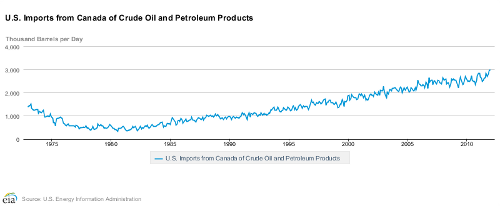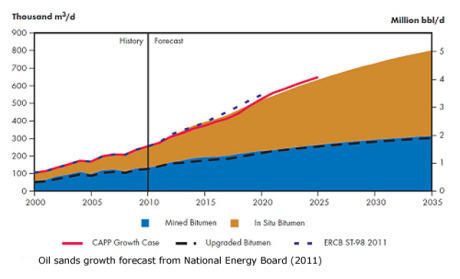
Given the amount of rhetoric we’re exposed to these days about U.S. energy independence, you’d think our addiction to foreign oil would be headed downhill — even if only at a snail’s pace.
And to a certain extent, our imports have been declining…
According to the EIA, our crude oil imports from OPEC members declined by 358,000 barrels last year compared to 2010.
But there’s one place we keep going for more crude.
Last October, we said our Canadian petroleum imports would soon top three million barrels per day.
It didn’t come as much of a surprise when we hit that benchmark just three months later.

It’s hard not to be bullish on the Canadian oil sands, especially considering it accounts for nearly the country’s total production:
click chart to enlarge
Within the next two decades, that share may be well over 75%.
The only question is how soon it will be until they start shipping us four million barrels per day.
How about five?
Unfortunately, we may be taking our neighbor’s energy for granted, because we’re not the only ones eyeing up Canada’s future barrels…
170 Billion Barrels or Bust
Extracting the 170 billion barrels of bitumen reserves beneath Alberta’s soil seems like an immense task.
I have no doubt you’ve heard the horror stories.
The massive surface mining operations that can be seen from space are enough to keep environmentalists up all night. I’ve seen it firsthand, and it isn’t a particularly pretty sight.
Buy we’re still holding on to my bullish outlook.
Because we realize the future of the oil sands isn’t from the trucks and shovels working day and night to dig up the bitumen.
It’s in extracting the part of the resource that’s too deep for mining.

We’ve mentioned before that about 80% of the bitumen needs to be produced through in-situ methods.
The choice for investors on where to put their money is far simpler than you might think.
They can play both.
How Investors Can Play the Field
Yesterday, Nick Hodge covered a broad spectrum of ETFs and ETNs to help diversify your exposure to the volatility inside the oil and gas industry…
This also holds true in the Canadian oil sands sector.
We’ve already seen the long-term growth expected in the oil sands during the next two decades.
Just some of their top holdings are among the strongest producers in the oil sands patch, including:
-
Suncor Energy
-
Imperial Oil
-
Cenovus Energy
-
Canadian Oil Sands Limited
It’s interesting to note that most U.S. investors don’t realize how close Canada is to adding China to their customer base. That’s a billion new friends willing to buy Canadian crude.
This year, China is expecting to import an average of six million barrels per day.

Now consider how the U.S. government is handling the Keystone XL Pipeline approval process…
Election politics aside, there’s only so much our neighbors to the north will endure.
Canadian Prime Minister Stephen Harper has been making Canada’s position very clear, saying:
Look, I’m a strong believer in the economic importance of our relationship, the security importance, and the importance of the United states and the World. But we cannot take this to the point where we are creating risk and significant economic penalty to the Canadian economy.
Truth is Canadian oil producers are selling their product at a substantial discount to Brent crude.
It’s only a matter of time before they begin to ship their barrels across the Pacific.
And believe me — it’s not just Canadian oil producers that will be taking advantage of the Far East…
Here’s another way to play the burgeoning Chinese-Canadian relationship.
Until next time,

Keith Kohl
A true insider in the energy markets, Keith is one of few financial reporters to have visited the Alberta oil sands. His research has helped thousands of investors capitalize from the rapidly changing face of energy. Keith connects with hundreds of thousands of readers as the Managing Editor of Energy & Capital as well as Investment Director of Angel Publishing’s Energy Investor. For years, Keith has been providing in-depth coverage of the Bakken, the Haynesville Shale, and the Marcellus natural gas formations — all ahead of the mainstream media. For more on Keith, go to his editor’spage.


 @KeithKohl1 on Twitter
@KeithKohl1 on Twitter










